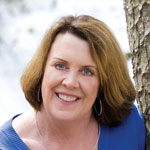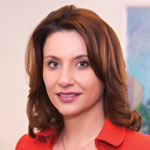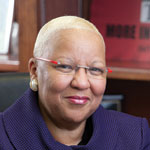INVESTIGATING ICE
Doing science in the polar regions is not for the timid – even at 39,000 feet. But Michael Studinger, an associate research scientist in UMBC’s Goddard Earth Sciences and Technology Center (GEST) and in NASA’S Operation IceBridge, have been flying over Antarctica’s polar ice and glaciers on missions to measure the thickness of the sea ice surrounding the continent.
Operation IceBridge is in the second year of a six-year mission, working out of Punta Arenas, Chile, at the southernmost tip of South America. Among the project’s goals is to get closer measurements of changes in the ice sheets and glaciers that cover almost the entire continent than can be obtained by satellite imagery.
Looking more closely at ice – and making more exact measurements – will allow scientists to better assess the continuing impact of climate change.
“We had many projects going but we were trying to understand the processes and ways ice sheets and environment respond to things like warming ocean temperatures and wind patterns,” says Studinger.
While NASA has satellites overhead collecting data, the agency also wanted measurements from the plane it could compare with what the satellites reported. So NASA converted a DC-8 airliner into a research aircraft for 20-30 crew members and scientists, including those from NASA, the University of Kansas, and Columbia University. Studinger says the plane was “amazingly well-suited for what we do.” And the demands made on Operation IceBridge’s scientists and aircraft were not insignificant. The expeditions to the Antarctic sometimes took 12 hours from Punta Arenas to the southern ice and back, and the flights are often stymied by mechanical problems and atrocious weather.
Despite these challenges, Studinger says that the scientists flew 85 percent of their allotted flight time (115 hours in the air) and travelled 40,098 nautical miles to obtain most of the measurements they sought.
Studinger joined UMBC in March 2010. He earned a masters degree in geophysics from the University of Munich and a Ph.D. from the University of Bremen while working at the Alfred Wegener Institute for Polar and Marine Research at Bremerhaven. He worked at the Lamont-Doherty Earth Observatory of Columbia University before coming to Baltimore.
Studinger also blogged for NASA’s website about Operation IceBridge, where he posted photos and maps of the mission’s progress.
“When the pilots ask you if it would be a problem if the belly of the aircraft is facing the sun, you know you are in the world of research flying,” Studinger blogged in one entry.
Much of the mapping that Studinger and his colleagues accomplished was done with NASA’s Land, Vegetation and Ice Sensor (LVIS), which aims a laser pulse at the surface which reflects back to the plane. The instrument makes a simple calculation: the time it takes for the pulse to return to the plane is divided by two (half the round trip) and then by the speed of light. GPS receivers mark exactly where the plane (and the instrument) was when the pulse was fired and a gyro tells how it was aimed. That information allows scientists to determine the surface elevation of the ice.
Getting precise measurements, sometimes within centimeters, was complicated – and cold. But Studinger hopes to have his analysis of the new data completed in the next six months.
— Joel N. Shurkin
Image: Sea ice is seen out the window of NASA’s DC-8 research aircraft as it flies 2,000 feet above the Bellingshausen Sea in West Antarctica on Wednesday, Oct., 21, 2009. This was the fourth science flight of NASA’s Operation IceBridge airborne Earth science mission to study Antarctic ice sheets, sea ice, and ice shelves. Photo: NASA/Jane Peterson
BRINGING THE PEACE CORPS HOME
When Americans wonder what good the Peace Corps and its far-flung volunteers do for them, they can often look and see benefits in their own communities, thanks to UMBC and the Shriver Center.
The UMBC Shriver Peaceworker Program is a gateway that helps the young volunteer-scholars returning home from service abroad hone the cross-cultural communication skills they’ve acquired and apply them to local challenges. A November panel held on campus – “Practical Idealists: Bringing the World to Baltimore” – offered program participants and other local leaders an opportunity to assess the difficulties underserved Baltimoreans face and highlight strategies to mobilize and deploy local resources to help address them.
“Baltimore is a hard city to love,” reflected Ed Orser, professor emeritus in American Studies at UMBC and a former Peace Corps member. “But at the same time, it’s a city that’s in so much need of love and so much need of understanding.”
The two year service-learning program is open to Returned Peace Corps Volunteers (RPCVs) and integrates graduate study, community service, and ethical reflection into a cohesive program that benefits both volunteer and community. Over 125 RPCVs have received graduate degrees through the program as they continue to develop their already demonstrated skills and commitment to public service closer to home.
“It’s very hard just on your own to go show up on some city street and say, ‘Hey, I’m here to help,’” noted Sally Scott, Senior Program Officer for the Association of Baltimore Area Grantmakers.
The panelists urged local leaders to focus on community assets rather than deficits, and stressed the ability of volunteers to have a genuine impact.
“You could throw a rock in West Baltimore and hit two artists,” observed Ashley Milburn, director of The Culture Works Project. “Artists who were selling drugs, who were beating up people, who were sitting on a curb, who were trying to raise a kid. But they were art-makers. So, what do you do with them?” Milburn’s group uses arts and culture as organizing tools to help build more resilient West Baltimore communities.
Scott reiterated the power motivated individuals such as Milburn can have, particularly when they work though locally based non-profits: “I’ve really found that over time it’s these groups that come together through a sense of passion, a sense of mission, that – as individuals come and go, and funders come and go – can sustain a sense of forward motion for these parts of Baltimore, which in many cases would otherwise be forgotten and left behind.”
The Shriver Center also presented its third annual Practical Idealist Award to alumnus Richard Kimball ’10, Ph.D., health policy. Kimball served as a Peace Corps volunteer in Moldova and assisted Baltimore Homeless Services in redesigning the Baltimore Homeless Census in his time as a Peaceworker.
“Everyone has struggles and issues,” Kimball said. “We fall on despair and wonder…what the next steps are. But I hope that people will remember that service in whatever shape or form can make a difference.”
— Dinah Winnick
RAISING A RUCKUS
What does composer Linda Dusman, a professor and the former chair of UMBC’s Department of Music look for when she goes to a contemporary music concert?
“People who enjoy going to contemporary music concerts go for the surprises,” says Dusman. “And to be surprised at a concert can be a really rejuvenating experience.” Contemporary classical music — or “new music”— often struggles with a perception that it’s a challenge for audiences. But in a concert setting, its enthusiasts can thrill to the surprises that it offers them: complex and shifting rhythms, harmonies and timbres from traditional instruments mingling with live or recorded electronic sounds.
Music faculty at UMBC embrace new music’s surprises as well. Not only has the campus become known nationally as a center for composers and performers, but UMBC faculty have even formed their own chamber ensemble to play new music, which they’ve dubbed Ruckus.
“The word ‘ruckus,’” says UMBC Department of Music chair E. Michael Richards, the group’s clarinetist, “signifies a burst of diverse, and sometimes conflicting, activity. It seems to conveniently represent the pluralism and diversity of music today.”
Adds Ruckus’s flutist, Lisa Cella, an assistant professor in the department: “We felt the name of our group should really represent the kinds of personalities we have, and the way we interact.”
Ruckus has played at Stanford University, the University of Virginia, the Smithsonian Institution, the Baltimore Museum of Art and other venues. In October 2010, the ensemble performed on campus at a keystone event in the Department of Music’s Livewire Festival.
Livewire was a four day extravaganza of new music performances, events and lectures that brought together new music aficionados from around the country. Richards and Cella were joined in the Ruckus performances by department colleagues including violinist Airi Yoshioka (associate professor), violist Maria Lambros (adjunct associate professor), cellist Gita Ladd (affiliate artist), percussionist Tom Goldstein (associate professor), Stephen Caracciolo (assistant professor), and guest pianist Audrey Andrus.
At Livewire, Ruckus performed compositions by Sofia Kamayianni, Anneliese Weibel and Leondardo Polato, and also played work by two local composers, Douglas Boyce, an assistant professor at George Washington University, and William Kleinsasser, a professor at Towson University.
“Bill Kleinsasser wrote the piece knowing us as players,” says Richards. “In his piece, ‘Adagio Amore,’ a computer interacts in real time with the performers. Music is really a collaborative process, and we all prepare individually, so it’s very gratifying when the rehearsals take place as we begin to hear the piece.”
For many composers, the chance to know and work with the performers – as Ruckus often does – is a luxury. “Communicating through notation is always a challenge for composers,” Dusman says. “And then for performers to interpret what’s written is a challenge as well.”
It’s easy to forget that every classic work was once a new composition, and for Ruckus, the music they play can be very new indeed. “We attempt to be on the cutting edge of realizing music that’s been written recently,” says Richards, “even as recently as a month ago.”
— Tom Moore
SLIPPING THE NET
On December 21, 2011, the Federal Communications Commission (FCC) waded into the most controversial telecom battle of our time: net neutrality. Net neutrality seeks to ensure that Internet service providers (or, “ISPs”) – be they dial-up, broadband, or wireless – maintain the web as the free and flowing river of communication that revolutionized contemporary society.
Just how to do that is the subject of vituperative debate. Strict net neutrality advocates demand that all web traffic be treated equally. They say ISPs should be prevented from blocking or slowing certain data, or offering improved tiers of service based on ability to pay.
On the other hand, ISPs worry about managing their systems and making a profit in a strictly net-neutral world. Should customers who simply check email and surf the net pay the same rates as those who soak up bandwidth by downloading large files and streaming video? Why shouldn’t companies who offer web services – such as Netflix – pay a toll to provide services, just as consumers do to obtain them?
In a 3-2 vote in December, the FCC adopted new rules for net neutrality that tried to bridge these deep divisions – and pleased almost no one. The net neutrality outlook seems murkier than ever, especially since the FCC’s authority to make such rules has also been called into question.
Tim Brennan, a professor of public policy and economics, watched the debate with growing dismay before formulating his own ideas on net neutrality. “Both sides of the debate just seemed to be talking past each other,” he observes.
His proposal to keep the Internet free and flowing turns the net neutrality question on its head. Instead of issuing rules on what ISPs can’t do, Brennan suggests compelling ISPs to do something positive: a guarantee of a minimum quality standard for every Internet user.
Brennan’s idea reaches back to the notions of “universal service” that also drove the government to subsidize the broad expansion of telephone service in the previous century.
He observes that the federal policy intervention in that case was “justified, in part, on the idea that my phone is more valuable to me the more other people have phones…. In the Internet context, what struck me is that if you have a website, and you put a link on your website to my website, the value to you in being able to put that link on there, and thus, by extension, the value of having a website in the first place, depends on your confidence that if someone clicks on your link to my website, that they will get there.”
Instilling such confidence through a minimum quality standard, he says, will allow individuals and innovators to arrive – and potentially thrive – on the web (a key goal of net neutrality), while allowing the market for Internet service to grow and innovate without regulations.
“It’s not a compromise solution,” says Brennan. “But there are elements of compromise to it.”
Brennan’s paper on the topic has already netted him an invitation to a conference in Germany to talk about his ideas. He hopes to spread his minimum quality solution more broadly in the coming year.
— Richard Byrne ’86
Image courtesy of BASETREE
Tags: Winter 2011



